Content is from Kirkbride et al. 2006Kirkbride et al. 2006:
Kirkbride JH, Jr, Gunn CR, and Dallwitz MJ. 2006. Family guide for fruits and seeds, vers. 1.0. Accessed September 2020-January 2022. URL: https://nt.ars-grin.gov/seedsfruits/keys/frsdfam/index.cfm ., without modification.
Updates are forthcoming.
Fruits: Pistil(s) compound; 1; 1-pistillate; with carpels united. Fruit pericarpium; simple; capsulecapsule:
a dry, dehiscent fruit derived from a compound ovary ; ceratium capsulecapsule:
; ceratium capsulecapsule:
a dry, dehiscent fruit derived from a compound ovary (Cochlospermum), or loculicidalloculicidal:
(Cochlospermum), or loculicidalloculicidal:
type of capsular dehiscence, opening longitudinally through the locules (compare septicidal)
 capsulecapsule:
capsulecapsule:
a dry, dehiscent fruit derived from a compound ovary (Bixia orellana), or septifragalseptifragal:
(Bixia orellana), or septifragalseptifragal:
type of capsular dehiscence, splitting through the exterior wall suture(s) but not the septum(-a), the valves of the wall then separating from the septum(-a) and the locules thus opened directly to the outside
capsulecapsule:
a dry, dehiscent fruit derived from a compound ovary (not Spjut); capsulecapsule:
(not Spjut); capsulecapsule:
a dry, dehiscent fruit derived from a compound ovary not inflated; capsulecapsule:
not inflated; capsulecapsule:
a dry, dehiscent fruit derived from a compound ovary without operculumoperculum:
without operculumoperculum:
a dehiscent cap (or lid) of a seed or fruit that opens during germination or dehiscence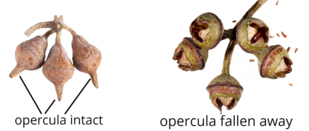 ; without persistent central column; not within accessory organ(s); with 1–2-carpellate, or 3–5-carpellate; with carpels united; with carpels remaining united at maturity; without sterilesterile:
; without persistent central column; not within accessory organ(s); with 1–2-carpellate, or 3–5-carpellate; with carpels united; with carpels remaining united at maturity; without sterilesterile:
lacking male and/or female reproductive parts; also, not producing fruit or seed
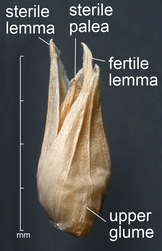 carpels; not sulcatesulcate:
carpels; not sulcatesulcate:
surface relief—having one or more elongate, relatively narrow and shallow depressions or grooves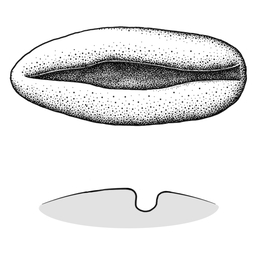 ; apexapex:
; apexapex:
the point farthest from the point of attachment, or the "tip" of an organ not beaked; dehiscentdehiscent:
not beaked; dehiscentdehiscent:
(v. dehisce) splitting open at maturity to release contents (of a fruit)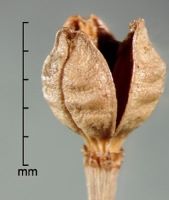 . Dehiscentdehiscent:
. Dehiscentdehiscent:
(v. dehisce) splitting open at maturity to release contents (of a fruit) unit seed(s). Dehiscentdehiscent:
unit seed(s). Dehiscentdehiscent:
(v. dehisce) splitting open at maturity to release contents (of a fruit) regularly; at apexapex:
regularly; at apexapex:
the point farthest from the point of attachment, or the "tip" of an organ ; and shedding seeds; without replumreplum:
; and shedding seeds; without replumreplum:
the rim, formed by the persistent placentas, and connected by a false septum in Brassicaceae fruits. The fruit valves are attached to this rim and separate from it in dehiscent fruits.
. Epicarpepicarp:
outer layer of fruit wall or pericarp, if divided into layers; note here used synonymously with exocarp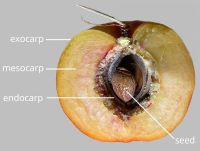 durable; with armature, or without armature; with bristles, or spines; without armature glochidiate; smooth, or not smooth; without wing(s); without apicalapical:
durable; with armature, or without armature; with bristles, or spines; without armature glochidiate; smooth, or not smooth; without wing(s); without apicalapical:
at or pertaining to the end of the seed or fruit distal from its point of attachment (i.e., base)
respiratory hole. Endocarpendocarp:
the inner layer of the pericarp, if divided into layers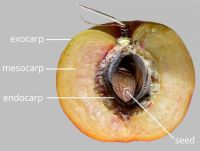 present; not separating from exocarpexocarp:
present; not separating from exocarpexocarp:
outer layer of fruit wall or pericarp, if divided into layers; note here used synonymously with epicarp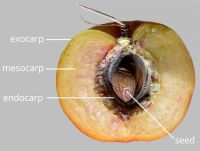 ; thin; not splitting into 1-seeded pyrenes; without wing; without operculumoperculum:
; thin; not splitting into 1-seeded pyrenes; without wing; without operculumoperculum:
a dehiscent cap (or lid) of a seed or fruit that opens during germination or dehiscence ; without secretory cavities; without mechanism for seedling escape; without longitudinallongitudinal:
; without secretory cavities; without mechanism for seedling escape; without longitudinallongitudinal:
of or relating to length or the lengthwise dimension
ridges. Funiculusfuniculus:
(alt. funicle) stalk connecting the ovule (later seed) to the ovary (later fruit) placenta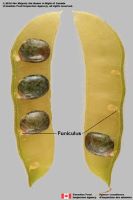 short; short without seed bearing hookswith hooks:
short; short without seed bearing hookswith hooks:
bristles or spines with curved or backwards pointing tips, or with secondary bristles along their length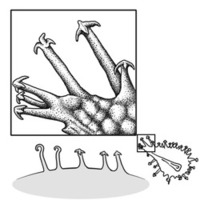 (retinacula); not persisting in fruit after seed shed.
(retinacula); not persisting in fruit after seed shed.
Seeds: Arilaril:
(broad sense) appendicular structure that wholly or partly envelops a seed and is produced from or a modification of the funicle, raphe, or outer integument; usually fleshy or pulpy, sometimes spongy or tufted-capillate, often brightly colored absent, or present (late developing in Bixia); a true arilaril:
absent, or present (late developing in Bixia); a true arilaril:
(broad sense) appendicular structure that wholly or partly envelops a seed and is produced from or a modification of the funicle, raphe, or outer integument; usually fleshy or pulpy, sometimes spongy or tufted-capillate, often brightly colored ; red; well developed; fleshy; encompassing. Seed larger than minute; 5 to less than 10 mm long; 5–7 mm long; curvedcurved:
; red; well developed; fleshy; encompassing. Seed larger than minute; 5 to less than 10 mm long; 5–7 mm long; curvedcurved:
(of embryo) linear embryo is curved into an arch or horseshoe with the ends far apart , or straight, or reniformreniform:
, or straight, or reniformreniform:
2D or 3D shape—kidney-shaped , or circularcircular:
, or circularcircular:
(of embryo) linear embryo is curved into an "O" shape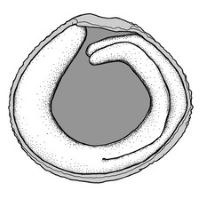 , or angularangular:
, or angularangular:
2D shape—having sides that meet at acute or obtuse angles
(sub-sub-:
a prefix meaning slightly, somewhat, or nearly (used with a descriptive term), or below (used with an anatomical term)
), or pyriform, or cochleatecochleate:
snail-shell-shaped. Relatively broad and short, basically round in transverse section, resembling a rapidly tapering spire overall, the exterior helically convoluted; like a snail shell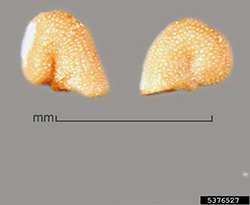 ; not bowl shaped; not nutlike; without winglike beakbeak:
; not bowl shaped; not nutlike; without winglike beakbeak:
a usually firm, terminal appendage, sometimes tapered ; without caudatecaudate:
; without caudatecaudate:
tapering to a long, tail-like appendage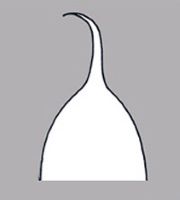 appendage(s); at maturity with food reserves; with endosperm; without canavanine. Sarcotestasarcotesta:
appendage(s); at maturity with food reserves; with endosperm; without canavanine. Sarcotestasarcotesta:
pulpy or fleshy outer layer of the seed coat, simulates aril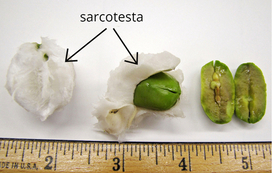 present, or absent; fleshy (Bixia). Testatesta:
present, or absent; fleshy (Bixia). Testatesta:
seed coat
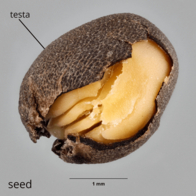 present; with fleshy or leatheryleathery:
present; with fleshy or leatheryleathery:
texture—moderately thick, tough, and very pliable
layer over hard layer, or without fleshy or leatheryleathery:
texture—moderately thick, tough, and very pliable
layer over hard layer; surface smooth, or unsmooth; surface with discreet raised features; surface tuberculatetuberculate:
surface relief—bearing small, warty, swelling, rounded, or variously shaped projections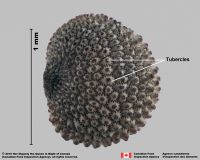 ; with crease or line separating cotyledons from hypocotyl-radicle, or without crease or line separating cotyledons from hypocotyl-radicle; with notch along margin where cotyledons from hypocotyl-radicle tip approaching each other, or without notch along margin where cotyledons from hypocotyl-radicle tip approach each other; without glands; without bristles; pubescentpubescent:
; with crease or line separating cotyledons from hypocotyl-radicle, or without crease or line separating cotyledons from hypocotyl-radicle; with notch along margin where cotyledons from hypocotyl-radicle tip approaching each other, or without notch along margin where cotyledons from hypocotyl-radicle tip approach each other; without glands; without bristles; pubescentpubescent:
surface relief—bearing hairs
(white hairs), or glabrousglabrous:
without hairs
(Bixa); with hairs over surface; with long hairs; densely hairy; with curly hairs; without agglutinated hairs; without mucilaginousmucilaginous:
resembling mucilage; moist and sticky
hairs; without glandularglandular:
surface relief—covered with small, raised secretory glands, regular or irregularly shaped, translucent or opaque, and maybe distinctly colored pubescence; without wings; without collar; without operculumoperculum:
pubescence; without wings; without collar; without operculumoperculum:
a dehiscent cap (or lid) of a seed or fruit that opens during germination or dehiscence ; colored; monochrome; gray, or red, or brown (all shades) (dark); not becoming mucilaginousmucilaginous:
; colored; monochrome; gray, or red, or brown (all shades) (dark); not becoming mucilaginousmucilaginous:
resembling mucilage; moist and sticky
when wetted; surrounding food reserve. Rapheraphe:
a ridge or seam on the seed coat, formed by the portion of the funiculus united to the ovule wall in longitudinally curved ovules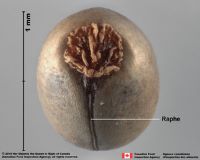 conspicuous (testatesta:
conspicuous (testatesta:
seed coat
 slightly groovedgrooved:
slightly groovedgrooved:
surface relief—linear depressions that may be single or form a series of grooves over the surface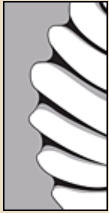 along rapheraphe:
along rapheraphe:
a ridge or seam on the seed coat, formed by the portion of the funiculus united to the ovule wall in longitudinally curved ovules ). Endosperm development nuclear; copious; fleshy; smooth; without starch, or with starch (Bixia); with oils and proteins; without fatty acid containing cyclopropene; without apicalapical:
). Endosperm development nuclear; copious; fleshy; smooth; without starch, or with starch (Bixia); with oils and proteins; without fatty acid containing cyclopropene; without apicalapical:
at or pertaining to the end of the seed or fruit distal from its point of attachment (i.e., base)
lobes; without chlorophyll; without isodiametric faceted surface; without odor. Embryo differentiated from food reserve; well developed; 1 per seed; partially filling testatesta:
seed coat
 (with food reserve); 0.7–0.9 times the length of food reserve; at one end of seed not extending into a depression or cup; axileaxile:
(with food reserve); 0.7–0.9 times the length of food reserve; at one end of seed not extending into a depression or cup; axileaxile:
on or of the axis
and centric; foliatefoliate:
appearing leaf-like
, or linearlinear:
(shape) long, narrow, and uniform in width; (of embryo) embryo is straight and much longer than wide ; with spatulatespatulate:
; with spatulatespatulate:
2D shape—like a spatula; rounded at the apex, with base long and tapered; (of embryo) embryo is straight and axile and centric with the cotyledons expanded to form the shape of a spatula or spoon; (of cotyledons) cotyledons expanded and wider than the stalk but not invested into the stalk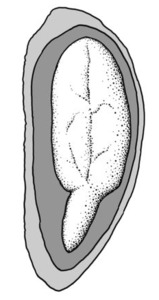 cotyledons; bentbent:
cotyledons; bentbent:
(of embryo) embryo is bent at an acute, V-shaped angle with the ends close together and generally thick cotyledons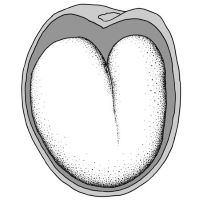 , or arcuate, or J-shaped, or U-shaped; with cotyledons gradually connected to hypocotyl-radicle; without coleorhiza; without simmondsin; without stomata; not green; with 2 or more cotyledons. Cotyledons 2; well developed; not divaricate; 0.7 times length of embryo; as wide as hypocotyl-radicle, or somewhat to significantly wider than hypocotyl-radicle; 1–2.8 times wider than hypocotyl-radicle; not concealing hypocotyl-radicle; thin; crumpled; smooth; with apicesapex:
, or arcuate, or J-shaped, or U-shaped; with cotyledons gradually connected to hypocotyl-radicle; without coleorhiza; without simmondsin; without stomata; not green; with 2 or more cotyledons. Cotyledons 2; well developed; not divaricate; 0.7 times length of embryo; as wide as hypocotyl-radicle, or somewhat to significantly wider than hypocotyl-radicle; 1–2.8 times wider than hypocotyl-radicle; not concealing hypocotyl-radicle; thin; crumpled; smooth; with apicesapex:
the point farthest from the point of attachment, or the "tip" of an organ entire; with margins connate; basally entire; equal in size; not punctatepunctate:
entire; with margins connate; basally entire; equal in size; not punctatepunctate:
surface relief—dotted with pits or with translucent, sunken glands or with colored dots, similar to pitted dotted. Hypocotyl-radicle moderately developed; curvedcurved:
dotted. Hypocotyl-radicle moderately developed; curvedcurved:
(of embryo) linear embryo is curved into an arch or horseshoe with the ends far apart (Cochlospermum), or straight (Bixa); not thickened.
(Cochlospermum), or straight (Bixa); not thickened.
General references: Corner, E.J.H. 1976. The seeds of Dicots, esp. vol. 2. Cambridge University Press, New York, Cronquist, A. 1981. An integrated system of classification of flowering plants, 1,262 p. Columbia University Press, New York, Engler, A. & K. Prantl. 1924 and onward. Die Natürlichen Pflanzenfamilimien. W. Engelman, Leipzig, Goldberg, A. 1986 (dicots) & 1989 (monocots). Classification, evolution, and phylogeny of the familes of Dicotyledons. Smithsonian Contr. Bot. 58 for dicots (314 pp.) & 71 for monocots (74 pp.). [Goldberg's illustrations are reproduced from older publications and these should be consulted], Gunn, C.R., J.H. Wiersema, C.A. Ritchie, & J.H. Kirkbride, Jr. 1992 & amendments. Families and genera of Spermatophytes recognized by the Agricultural Research Service. Techn. Bull. U.S.D.A. 1796:1–500, Mabberley, D.J. 1987. The plant-book, 706 p. Cambridge University Press, Cambridge, Martin, A.C. 1946. The comparative internal morphology of seeds. Amer. Midl. Naturalist 36:513–660, and Spjut, R.W. 1994. A systematic treatment of fruit types. Mem. New York Bot. Gard. 70:1–182.